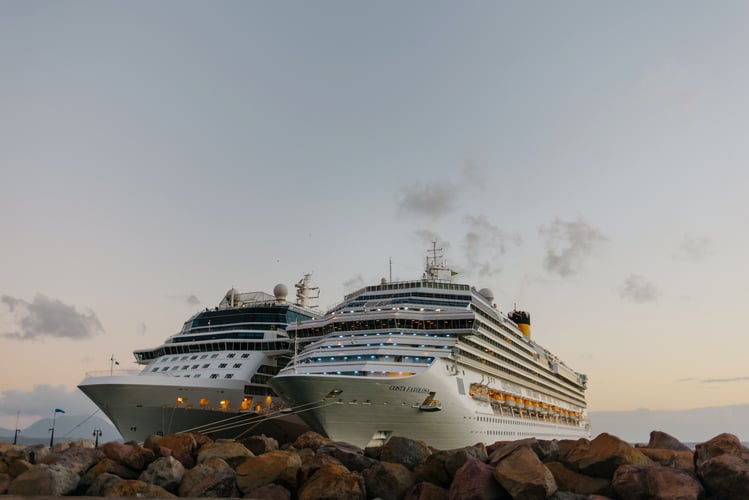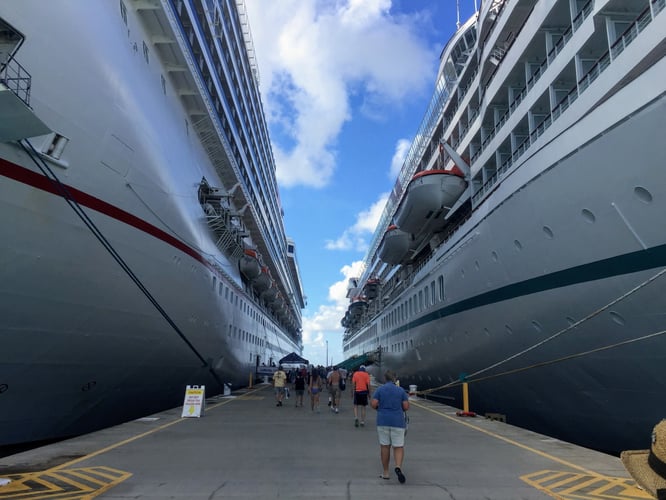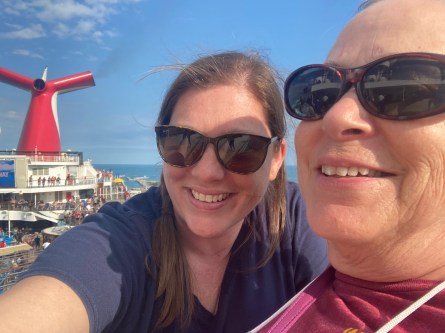Trip Review: Seven Night Mediterranean Cruise
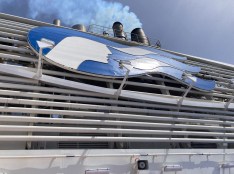
I had the opportunity recently to sail on the Regal Princess from Barcelona to Rome. This was my first time sailing Princess and my first time sailing anywhere other than the Caribbean. We had a lovely voyage, and I can’t wait to tell you all about it! For this trip, I took my friend Mary along with me but there was plenty to do – both on the ship and off – that would be great for family vacations.
I have a lot to discuss, so I’m going to break this article up into three main sections:
The Ship: Regal Princess
The Itinerary: Barcelona to Rome
Why I Think a Europe Cruise Should Be Your Next Family Vacation
The Ship: Regal Princess
The Regal Princess is one of Princess Cruise Line’s six Royal Class ships and was the first to fully incorporate the Medallion Class technology (more on that a bit later). It is a large ship, with seventeen decks and a passenger capacity of around 3500 people. She recently came out of a short dry dock, in which the paint and finishes were refreshed. A small bit of trivia about the ship is the nod back to the original “Love Boat;” the ship’s horn plays the theme song from the classic TV series, and there are a few artistic references to the series around the ship. Regal Princess generally sails Caribbean itineraries in the winter months, and Europe itineraries in the summer.
The Layout & First Impressions of the Ship
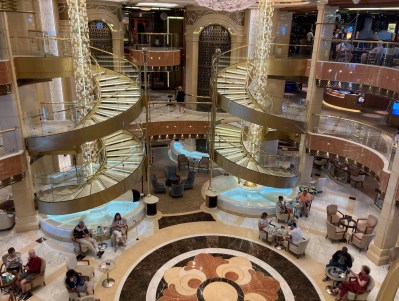
Regal Princess is a gorgeous vessel, with a multi-level main atrium anchoring the shopping and entertainment area midship. The color scheme and finishes are classy; the cream, brown and blue shades are relaxing and the dark woods and shiny marble nod back to my mental images of classic ocean liners. Everything sparkled the day we walked on the ship. I don’t know if this is a result of the recent dry dock, or if Princess ships always look like this, but everything we saw was “ship-shape and Bristol fashion.” I don’t recall seeing any cosmetic blemishes at all.
Three main dining rooms make up the bulk of the public space on the aft end of the ship, although there is also a lounge area used for presentations and smaller entertainment events. Additional lounges, dining options, shops, and the casino fill the central areas on decks 5-7, and the Lotus Spa is located to the front on deck 5.
The Lido Deck, located on deck 16, is where passengers will find the expansive buffet, ice cream stand, main pool, big screen, several bars, a couple of quick-service food locations, and the gym. Decks 17 & 18 have additional pools, an adults-only premium space, a walking track, sports decks, and plenty of loungers.
Our Stateroom
For this cruise, we chose to go with a standard inside stateroom. We had two main reasons for this: first, on a port-intensive itinerary, we didn’t plan to spend a ton of time in our room and second, I’ve found that the central location of an interior cabin actually decreases any chance of seasickness for me.
Our stateroom (C405) was located on Deck 10, the Caribe Deck. It was almost in the exact middle of the ship, with only staterooms both above and below. The layout was a bit different than I was expecting – in a good way. The orientation of this particular cabin was longer and not as deep; as a consequence, the door from the hall entered into the sleeping area, and the bathroom, closets, and dressing area were back and to the left. The layout felt more spacious and gave a bit more privacy than the “typical” interior stateroom. A few of the other interior rooms I peeped in had the more traditional design, so we may have just gotten a bit lucky. Our room had another guest’s stateroom on the aft side, but a mechanical closet on the forward side so we found it to be extremely quiet. We only heard hallway noise once or twice throughout the entire voyage.
The cabins are decorated mostly in shades of cream, with light cherry-colored wood accents. For two people, we had requested the split twin layout. This particular room did not have a sofa or drop-down bunks, so its maximum capacity is two passengers. There was plenty of storage space, with drawers in the desk area as well as the nightstands; two main closets for hanging items and a third closet with shelves and a small safe provided more-than-adequate room for all of our clothes. To be honest, we could have each brought twice as much stuff and still had adequate storage space. The bathroom was very small and a typical cruise ship bathroom. The shower had a detachable showerhead, a shower curtain, and a tall curb to keep water from sloshing out; this cabin had no tub. The towels were large and fluffy, and bathroom amenities included a shampoo/conditioner combo as well as body wash, soap and lotion. Two bathrobes were provided, although they ran a bit small which I found odd.
The outlet situation was fair, with three plugs in the main desk area (two standard US outlets plus one Euro outlet – bring a plug adapter). Two more plugs were along the wall near the beds; these outlets had the bedside lamps plugged into them, but they were accessible should you wish to use them for phone charging instead. A large tv takes up most of the real estate next to the door, but a desk/vanity area provides plenty of counter space. A hairdryer is provided in the vanity area, as well as a stateroom phone; no alarm clock is furnished, so bring one along if that is important to you. Under the desk, a small fridge is available for your use, and you can request a coffee/tea/kettle setup from room service at no charge.
Regal Princess Dining
Everyone knows that food is an integral part of the cruise experience. I am here today to tell you that the food we experienced on this ship was excellent overall. We did not pay any extra for any food on the ship; in other words, we only ate from the included venues. Over the course of seven nights, we had five dinners in the main dining room, two dinners at Alfredo’s Pizzeria, afternoon tea in the dining room, one main dining room breakfast, and several breakfast/lunch/snacks from the Lido deck buffet. Additionally, we ordered snacks through room service several times.
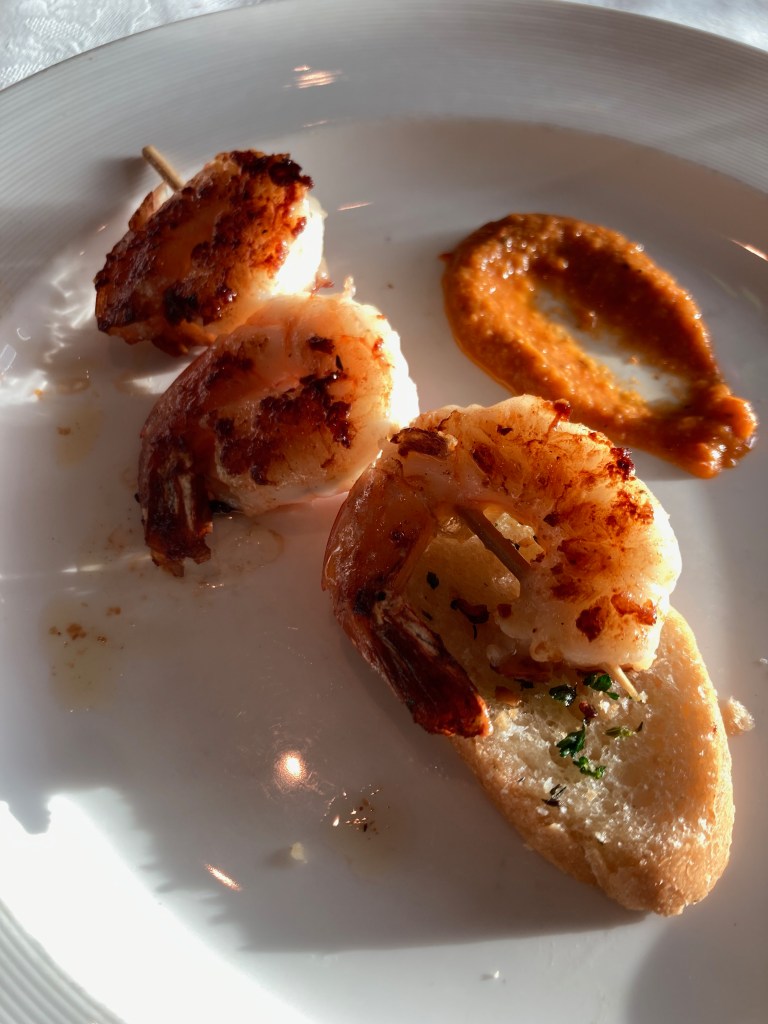
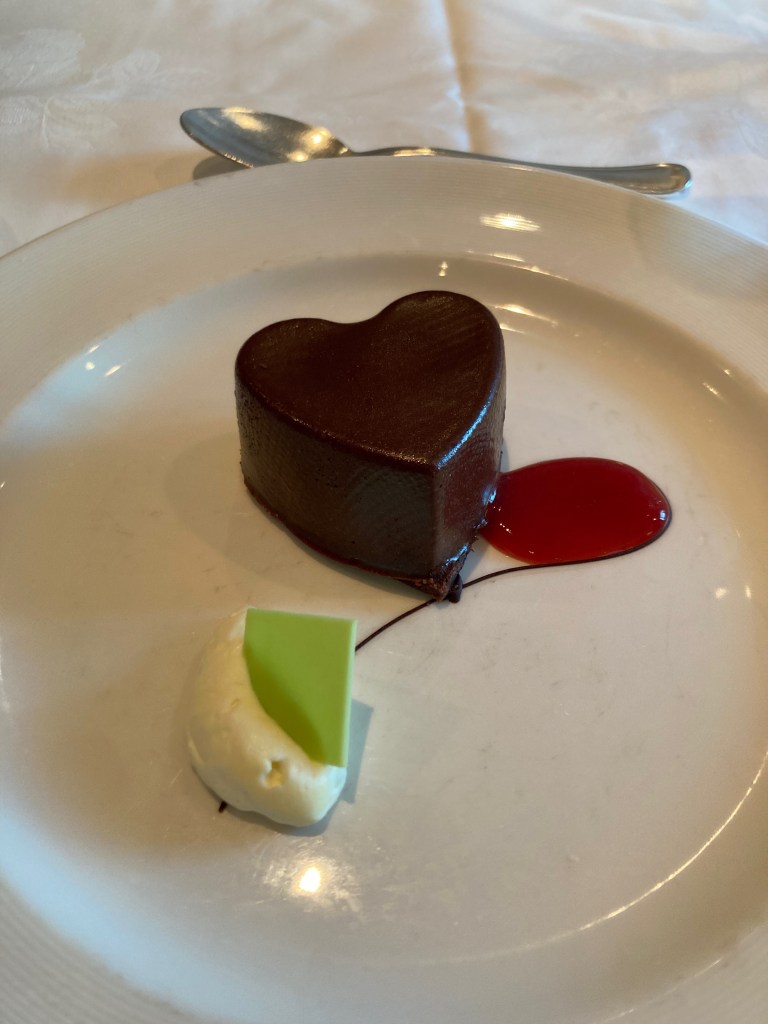
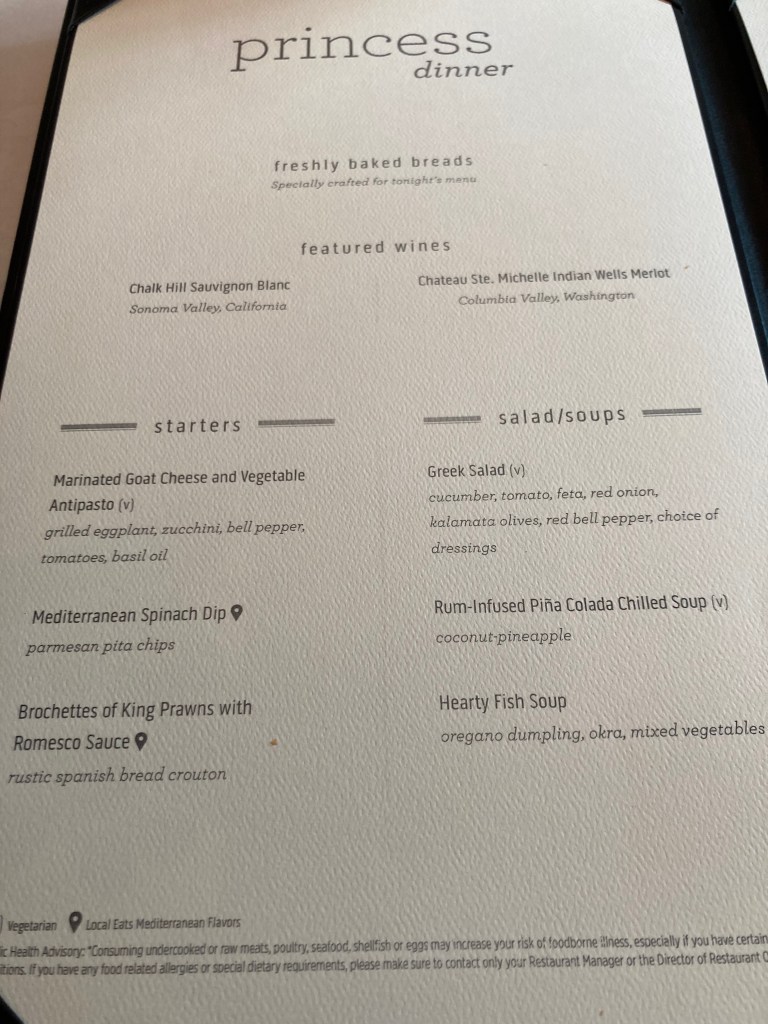
We found the food in the main dining room to be very good overall with only a couple of “misses.” Portion sizes were small, which was great because it allowed us to try a little bit of everything that looked good! For most dinners, we each had a starter, soup or salad, an entree, and dessert (or maybe two desserts…..). The menus were varied, and I don’t think I saw many entrees repeated over the course of seven nights. I had a really excellent surf & turf with steak and lobster one night, and another night I ordered a pork & polenta dish that I loved. My friend Mary really enjoyed trying the cold soups flavored with things like banana or mango.
Alfredo’s Pizzeria was really, really good. It compares with some of the better pizza I’ve had anywhere – not just on a cruise ship. Everything we ate there was really good, and it was never really crowded. I suspect many people on the ship didn’t realize it was complimentary.
The buffet was extensive and had tons of variety; almost everything we tried there was hot and fresh and generally of decent quality. They featured a different themed area every evening; one night, there was French food including escargot and crepes and on another afternoon, British fare like toad-in-the-hole and fish & chips was featured. I thought this was a fun way to keep in the spirit of the destinations on the cruise.
The room service menu was limited but we did enjoy the breakfast sandwiches, the fruit plates, and the turkey club. We also stopped by Swirls for ice cream several times; the first few days of the cruise, the ice cream machine was broken so they were serving hard-scoop ice cream. About halfway through the cruise, the soft-serve machine was fixed however! They always had vanilla soft-serve along with another flavor. My favorite was the tiramisu-flavored ice cream.
Medallion Class Overview
One thing that is unique to Princess Cruise Lines is their Medallion Class technology. Instead of a key card, you get a small round fob that acts as your room key, a token for charging items around the ship, a passkey for getting on/off at ports, and a locator beacon for the staff to find you on deck when you order food or drinks. The Medallion, as the fob is known, is provided free of charge along with a lanyard; you can purchase bracelets, necklaces, keychains, and other items to hold the fob instead of the lanyard if you wish.
The coolest thing about the Medallions is that they unlock your stateroom door from several feet away. This may not sound like much, but when you’ve got hands full of ice cream cones or sort of forgot which stateroom is yours, it’s really handy! Additionally, there are several interactive displays around the ship where you can tap your Medallion to look up things like your dining reservations, reserve shore excursions, review your onboard photos, and more.
The Medallion Class app is what you download to your phone and use to order food/drinks around the ship, communicate with new friends on board, and check the schedule of activities. If I have one negative thing to say about Princess Cruise Lines, it is that the app was clearly not designed very well from a user’s point of view. Some things were very intuitive (like making dining reservations) but others were clunky and tough to navigate. We completely gave up using it to try and plan out our activities on the ship, preferring to rely on the paper Princess Patter that was dropped off in our stateroom every night. Additionally, there were times throughout the cruise when it took a really long time to load or would kick us out of the app entirely. Fortunately, there are ways around this (ie, using your TV to order room service) but the app is one area where improvement is needed.
Services & Entertainment
The other area that needs a bit of improvement is the wifi. I know that the internet at sea is not always reliable, but I had a better internet experience with Carnival’s middle internet plan than I did with Princess’s internet package. The good thing about the Princess internet service is that it’s unlimited: you pay for either one device or four devices per stateroom, and there is no real limit on the number of minutes or amount of data you can use. It worked great for Facetime and Zoom calls with the exception of one evening at sea, but internet surfing and emails were a bit of a struggle.
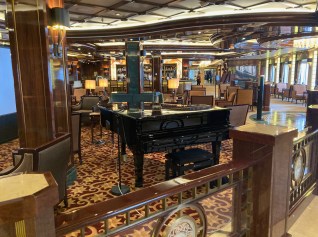
On the other hand, the entertainment aboard the Regal Princess was excellent. We really enjoyed the live evening shows, particularly the show called Bravo! Bravo featured four singers and four dancers, as well as a live (very small) orchestra. This group performed a number of songs from Broadway, opera, and hit songbooks; the singers were excellent and the dancing was top notch. There was an acoustic guitarist onboard named Cam Dunbar who was quite good, as well as a small jazz trio. The only musical act we didn’t really care for was the Xcite band that played out by the pool.
We also really liked the enrichment lectures, particularly after discovering we could watch them on our stateroom TV in the evenings instead of going to the actual lectures. The destination/port talks were really informative; the presenter talked all about where the ship would dock, instructions for how to disembark and get into town, and had tons of ideas of things to do if you didn’t want to take one of the ship’s excursions. We fell into a habit of watching these the night before our visit to each port and used several of the tips the presenter gave us. There was also a library on the ship with books and board games for passengers to borrow.
Finally, we participated in trivia (we won!) and basic Italian lessons. We did not play BINGO or visit the casino or play any sports on Deck 18, but there were plenty of opportunities for all of those things if we wanted to participate. We preferred to find a quiet spot on the deck and enjoy the sunshine and a good book.
Staff
The staff onboard our cruise were outstanding. Our stateroom steward, Elmer, was super friendly and very willing to accommodate any request we had. The cruise director, Aaron, was funny, informative & engaging and the waitstaff at dinner was friendly and eager to please. I thought the staff did a nice job finding the right balance of providing excellent service along with a dash of jocularity. Several of our fellow cruisers were doing several weeks in a row on the ship, and it was easy to see the genuine camaraderie that many of them had with members of the staff.
Overall thoughts on the Regal Princess
I cannot recommend Regal Princess highly enough. Everything was clean, details were taken care of, and the staff was outstanding. Despite a few minor challenges with the wifi and the app, the major components of our vacation went smoothly and I would 100% cruise on Princess again in the future.
The Itinerary: Barcelona to Rome
Now that you’ve read my rundown of the ship, here are some thoughts about our itinerary and the day-by-day highlights of our trip.
Pre-cruise travel
In the age of covid, it’s really important to keep a close eye on any travel restrictions or requirements; they can and do change frequently. Fortunately for us, the changes that occurred shortly before our trip were for the better. We did have to do a covid test prior to boarding the ship, but these could be completed at any time in the three days prior to embarkation. This meant we could test at home before even boarding the airplane; both of us chose to use Walgreen’s rapid drive-through test and passed.
Additionally, we had a few housekeeping items that needed to be completed before our flight. American Airlines and its partners use the Verifly app to check covid-related paperwork like vaccines, tests, and any necessary passenger locator forms. As of the time of our departure, Spain was still requiring proof of vaccine or negative test for non-residents to enter the country which meant we had a pre-travel health form we needed to complete. Often, these forms can only be completed within the last day or so before you fly, and produce a QR code that you will need to show upon arrival.
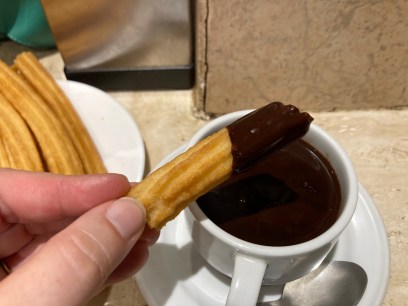
We left Gainesville around noon on Thursday, May 20, and had a multi-hour layover in Charlotte, which we spent at The Club airport lounge. I’ll have to do a separate post about airport lounges, but I highly recommend checking them out if you’re able. Our flight from Charlotte to Madrid was relatively uneventful, despite the lack of sleep. Leaving the airport, we took public transit into the city center. After dropping our bags at a luggage storage facility, we meandered through the old part of town, stopping for churro and chocolate at Chocolateria San Gines which has been serving fried dough since 1894.
Next up was a walking tour of the Plaza Mayor and the Royal Palace. I had intended to book tickets ahead of time for just the royal palace but broke my own cardinal rule of travel and failed to do so in a timely fashion. Rather than wait in line for many hours, we joined a guided tour that allowed us to enter via the group’s entrance with no wait. This option cost us a little bit more but came with a guide who gave us quite a bit of information about the city and what we were seeing. My favorite part of the tour was seeing the collection of Stradivarius instruments owned by the royal family (no pictures allowed, of course).
After our tour of the palace, we headed back to the train station to collect our bags and hop a train for Barcelona. Once there, we took the subway to our hotel, ate a quick dinner of tapas, and crashed out for the night before the sun had even fully set.
May 21: Barcelona & Embarkation
Our major priorities for our morning in Barcelona were to see the famous Gaudi church Sagrada Familia and have a chance to wander through the Gothic quarter. Fortified by a hotel breakfast and lots of coffee, we snagged an early reservation for the church and headed out to see the city.
Sagrada Familia is a cathedral started by the artist Antoni Gaudi in 1882 and it is famously unfinished nearly 100 years after the artist’s death. The roof was only completed in the last decade or so, and visitor entrance fees continue to finance the project. Its a difficult building to describe, and unlike any cathedral I’ve seen before. The architecture is organic, with images of plants carved into the facade. Nothing goes in a straight line. But what struck me most was the light; the stained glass windows were placed in such a way that the blues and greens are illuminated in the morning light, while the reds and oranges illuminate the church in the afternoon hours. The overall effect is simply marvelous.
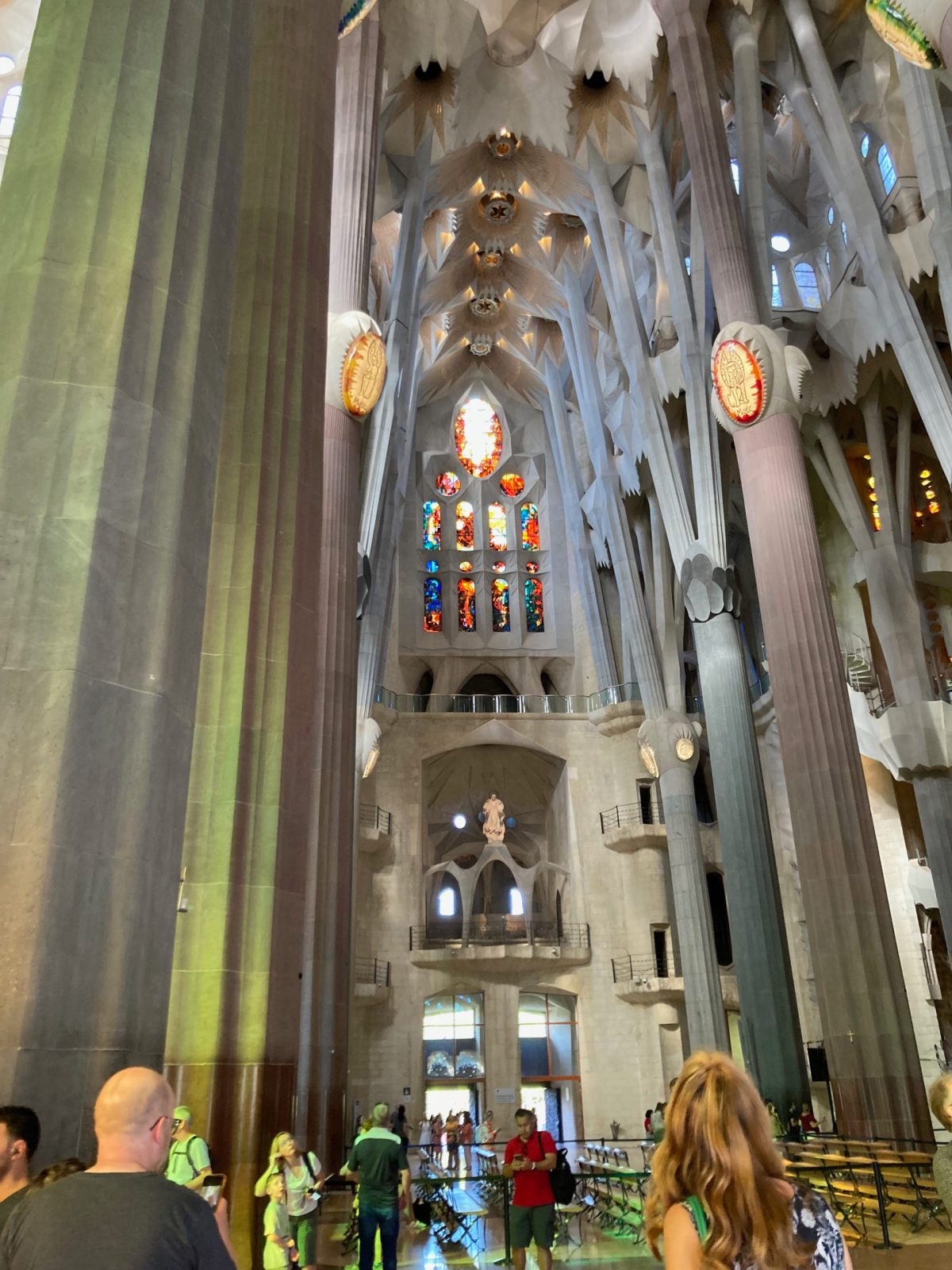
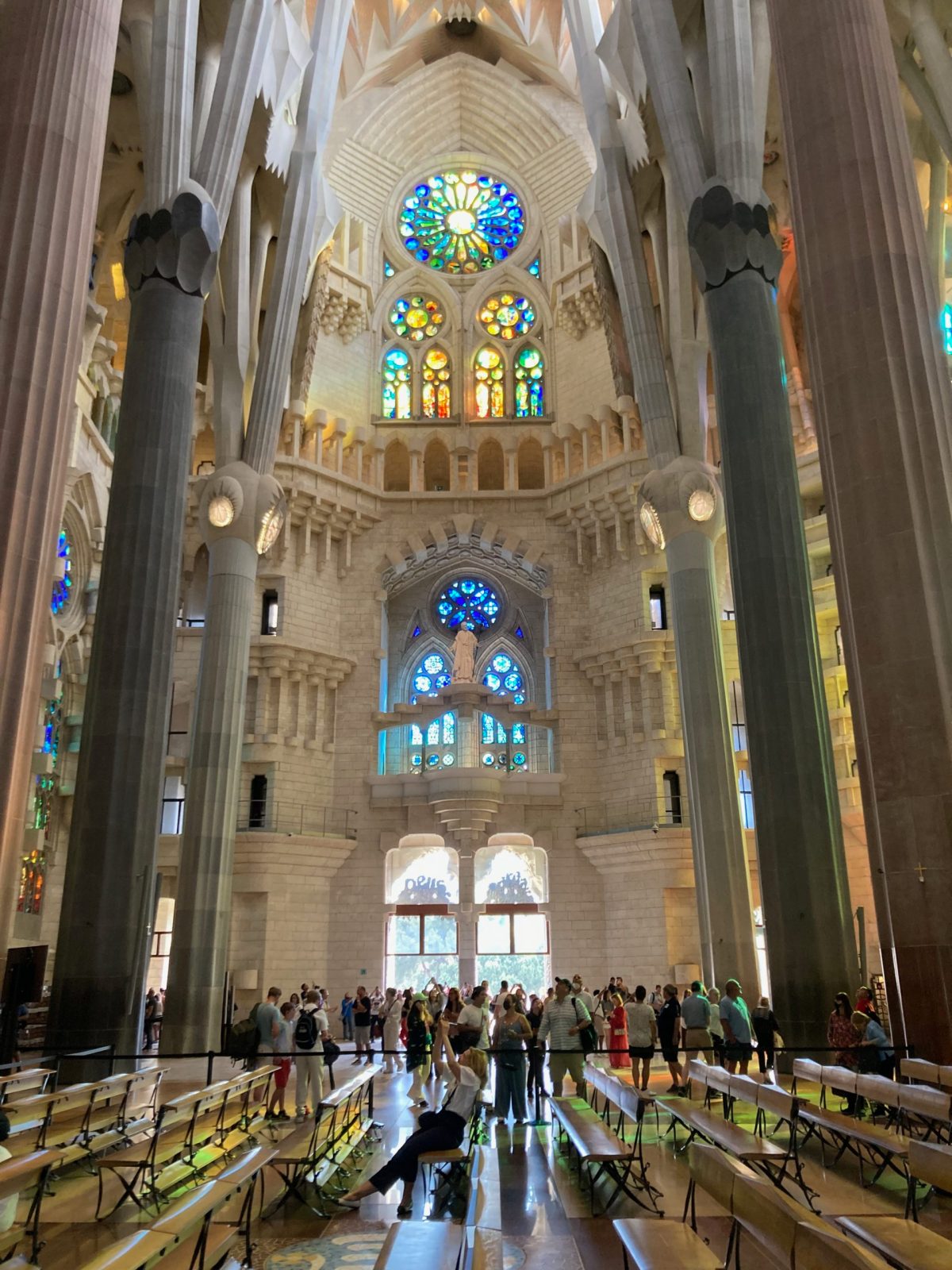
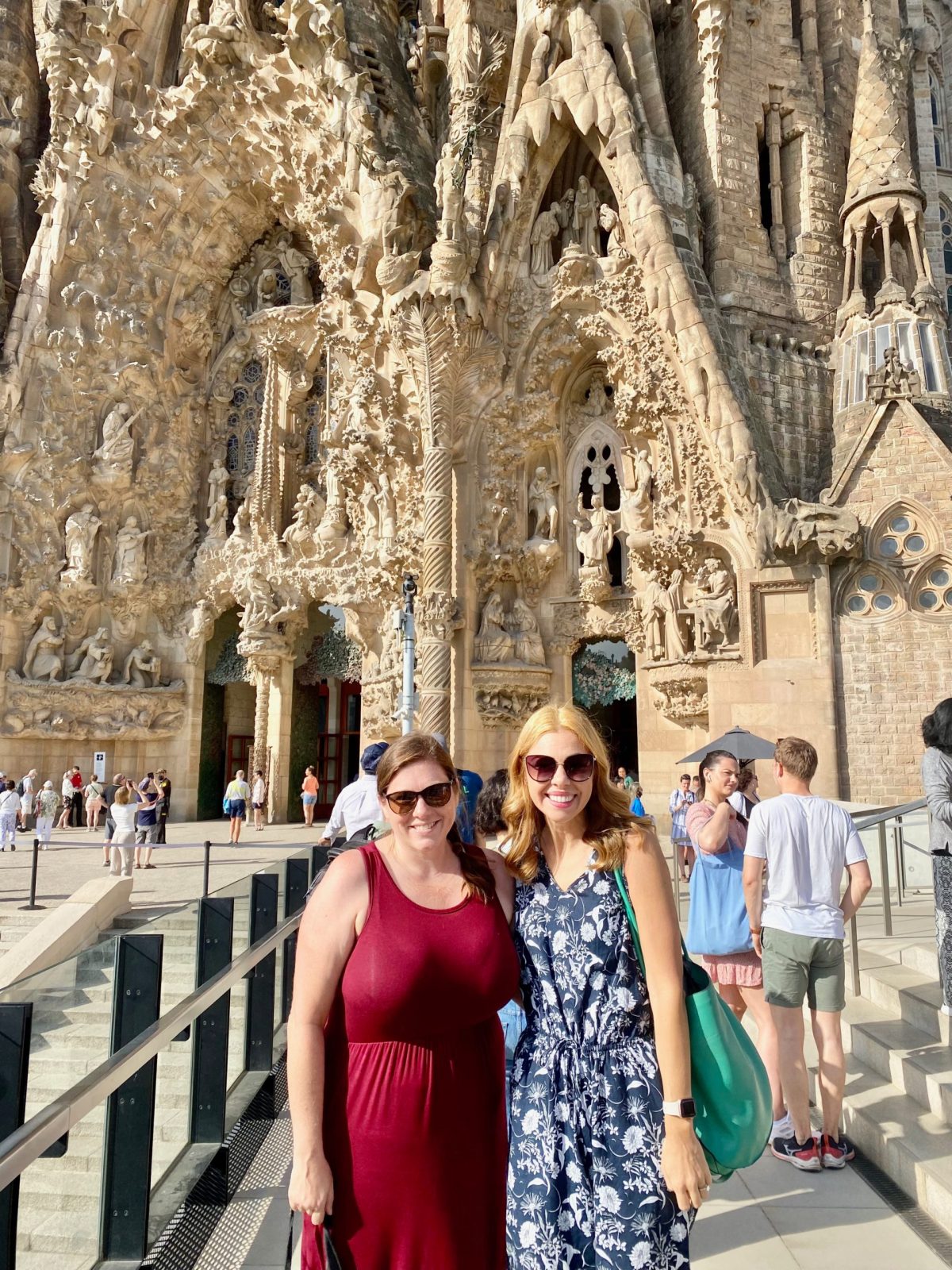
After our trip to Sagrada Familia, we walked through Barcelona to the Barri Gothic; this is the old medieval part of Barcelona. I always enjoy seeing street performers in Europe, and there was one guy in Barcelona who had a whole piano that he just wheeled out onto the street. By this time, we were ready to head to the ship so we hightailed it back to our hotel, grabbed our stuff, and hopped in a cab to the port.
One of the nice things about cruising from Barcelona is that the cruise port is just a few miles from downtown. The cab ride from our hotel cost about 20 euro, and took less than half an hour. We dropped our luggage with the porters outside and headed into the shiny new terminal to check-in.
Princess uses their Medallion Class app to help expedite check-in at the port. Cruisers can set up their onboard payment preferences, submit copies of their passport, and upload vaccine paperwork to the app before the cruise – which we did. A quick trip through the metal detectors and a few minutes with a crew member verifying that we had tested negative for covid, and we were able to walk right on the ship.
Our first stop on the ship was the Lido deck to hit up the buffet. The buffet is huge, taking up the back third of the ship. Regal Princess holds about 3500 passengers, but this particular sailing had only 2600 on board; additionally, about half of those were cruising a two (or three) week itinerary, and Barcelona was “just” a port day for them. The result was a fairly empty ship and buffet when we arrived – a huge contrast to the scene at the buffet when you board a ship for a Caribbean cruise!
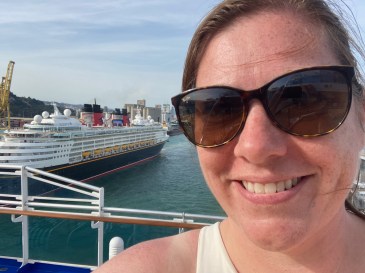
The other outcome of a half-empty ship was that our room was ready and our luggage had already been delivered by the time we finished lunch. We quickly changed into our swimsuits, and found some lounge chairs at the Terrace Pool at the rear of the ship where we spent the remainder of the afternoon.
Dinner on embarkation night was in the main dining room, which we enjoyed very much. Unfortunately, jet lag was catching up with us so we were in bed and asleep before the ship even departed the port!
Miles walked: 9.4
Embarkation costs, per person: $15, includes taxi from hotel to ship
May 22: Day at Sea
Our first full day was a day at sea. I was really grateful to have a “recovery” day and we spent quite a bit of the day relaxing by the pool. We ate breakfast in the main dining room, and I was able to nab an open spot for a last-minute massage.
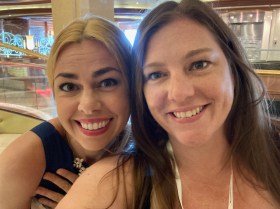
After lunch in the Lido buffet & hanging by the pool, we went to the “Basic Italian Lessons” and then got dolled up for formal night in the Main Dining Room. We enjoyed taking some “prom style” photos around the ship and listened to some live music before heading off to bed!
Sea days always seem to go so quickly, even when there is nothing really planned! As you can see from the documents below, there’s always a lot going on around the ship and you can be as active or inactive as you like. On this trip, we really enjoyed la dolce far niente (the sweetness of doing nothing)!
Miles walked: 8.6 (entirely on the ship!)
May 23: Gibraltar
Prior to the cruise, I was really excited to visit Gibraltar; this tiny speck of the United Kingdom floating at the very southern tip of Spain seemed like a slightly obscure place to visit, and I love the slightly obscure or offbeat when traveling. Gibraltar is strategically located at the entrance to the Mediterranean Sea, and has been an important location since Roman times. Despite some ongoing friction between Spain and England, Gibraltarans are proud to be citizens of the United Kingdom. If you’ve ever craved fish & chips when it’s 90 degrees out, Gibraltar is the place for you.
As was typical for us on this trip, we chose not to participate in any of the excursions offered by the ship. One of the main benefits of a European cruise is that ships often dock in/near the center of town, making it easy to get to some of the top sights by public transit, taxi or even your own two feet. Gibraltar was no exception to this rule; from the ship, it was about a 30-minute walk into the center of town.
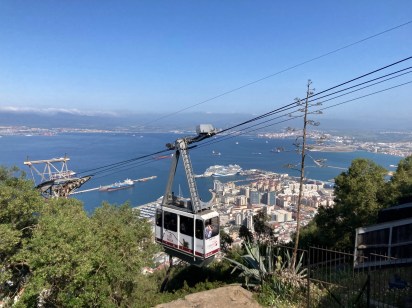
Our plan for the day was to take the Cable Car to the top of the Rock of Gibraltar and then hike down, making stops at the cave and the ape’s den on the way. While we were walking through town, I hopped online and booked our tickets for the cable car & the Nature Reserve; this allowed us to skip most of the queue waiting to board and provided prepaid entry to all the sights up top. We still had to wait a few minutes, but before too long we were zipping our way through the six-minute ride to the top. Views from the top were quite stunning, with the peaks of Jebel Moussa in Morocco just barely visible in the distance.
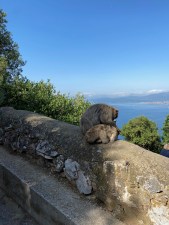
One of the other things that Gibraltar is famous for is the apes that live on the rock. There is a small colony of Barbary macaques who live there, and it is the only place in Europe where you can see monkeys in the wild. Many signs on the way up warned us that the monkeys were aggressive and that they like to steal snacks. We learned this the hard way when an ape jumped up onto my friend Mary’s purse and snatched a mask right out of it!
Luckily, that is all he grabbed. A few minutes later, we witnessed another monkey literally climb on top of another visitor, unzip her backpack, and grab her Ziploc full of snacks and run away. Seriously, these monkeys don’t play. Watch your snacks!
Once our hearts regained their normal rhythm, we started hiking down the rock; there are several sights along the way, and our first stop was St. Michael’s Cave. This cave, which is naturally occurring, has been expanded and turned into an events venue; it’s a short walk through but it had some of the more fantastic stalactite formations that I’ve ever seen in a cave.
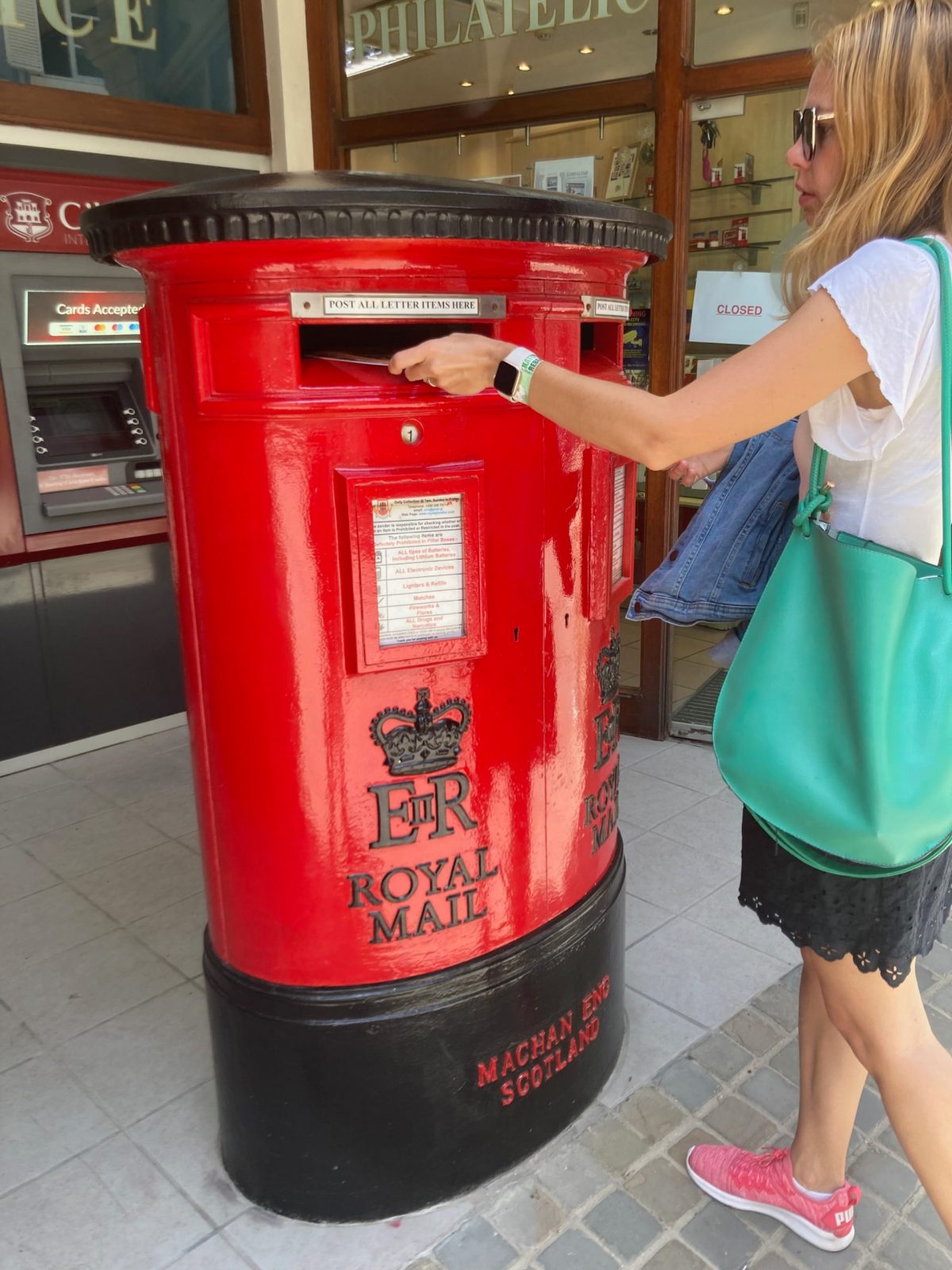

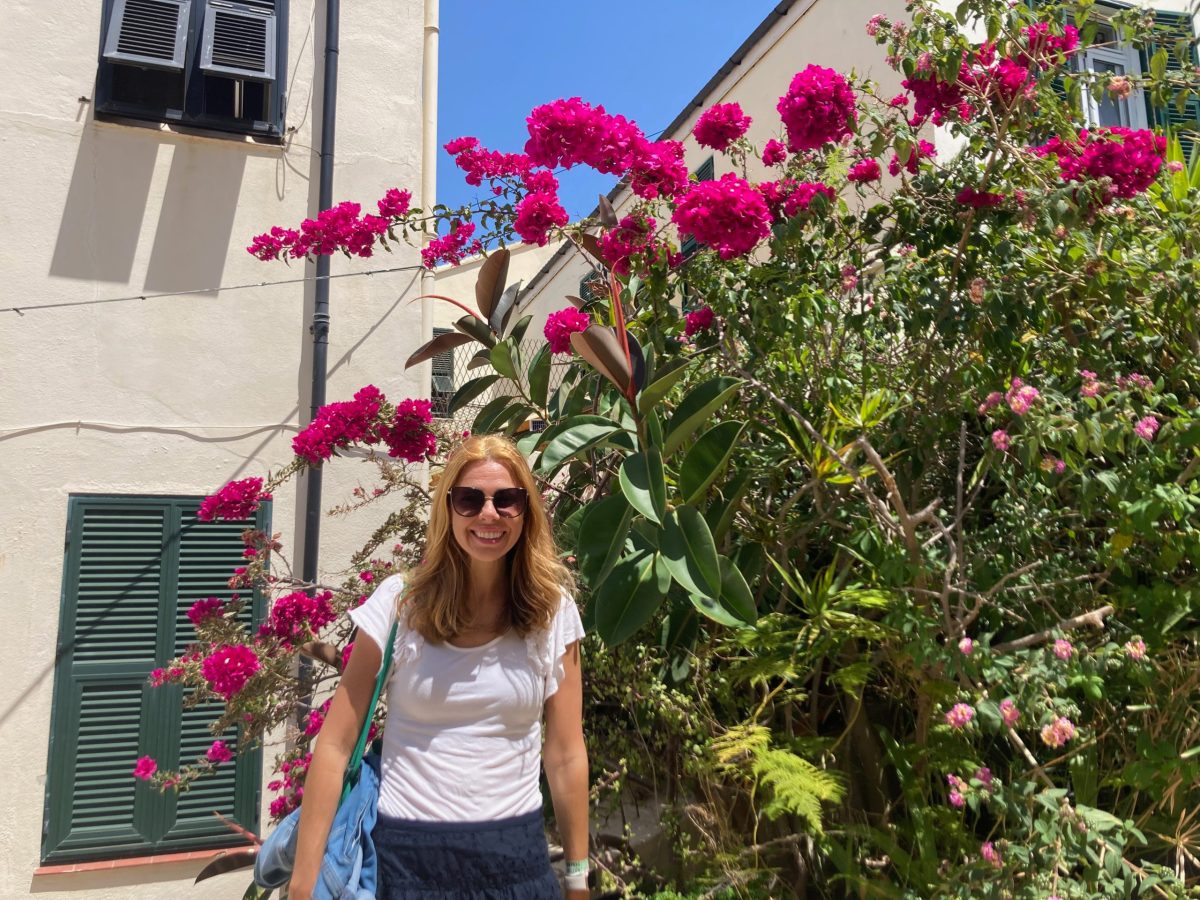
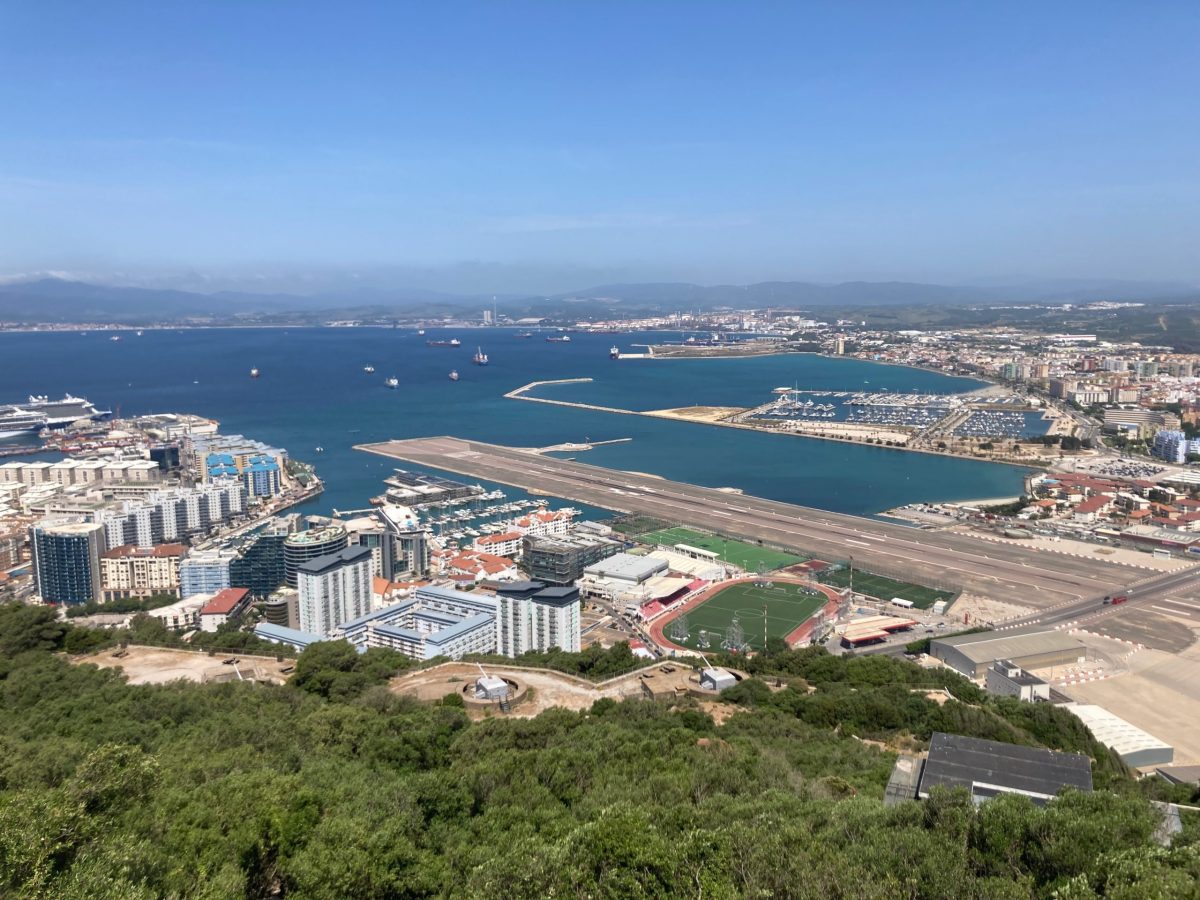
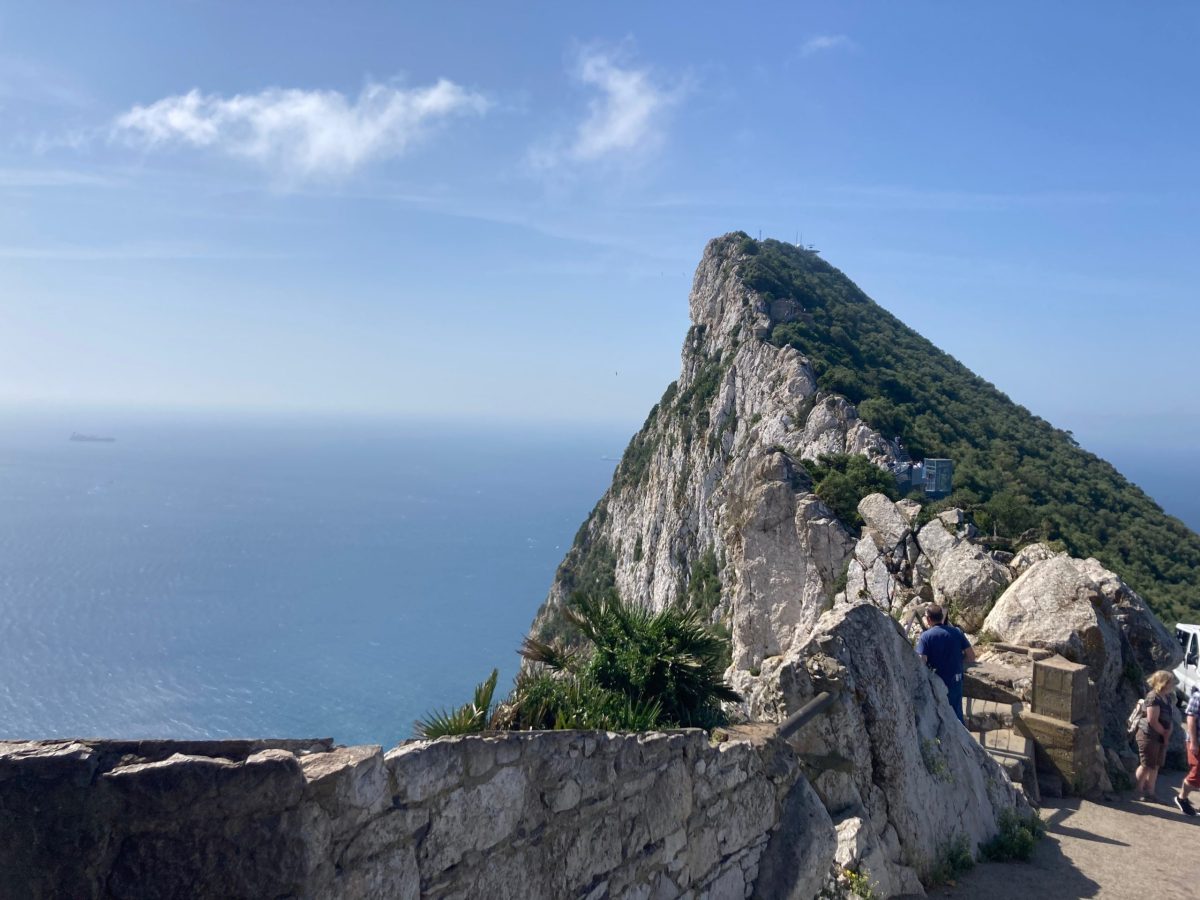
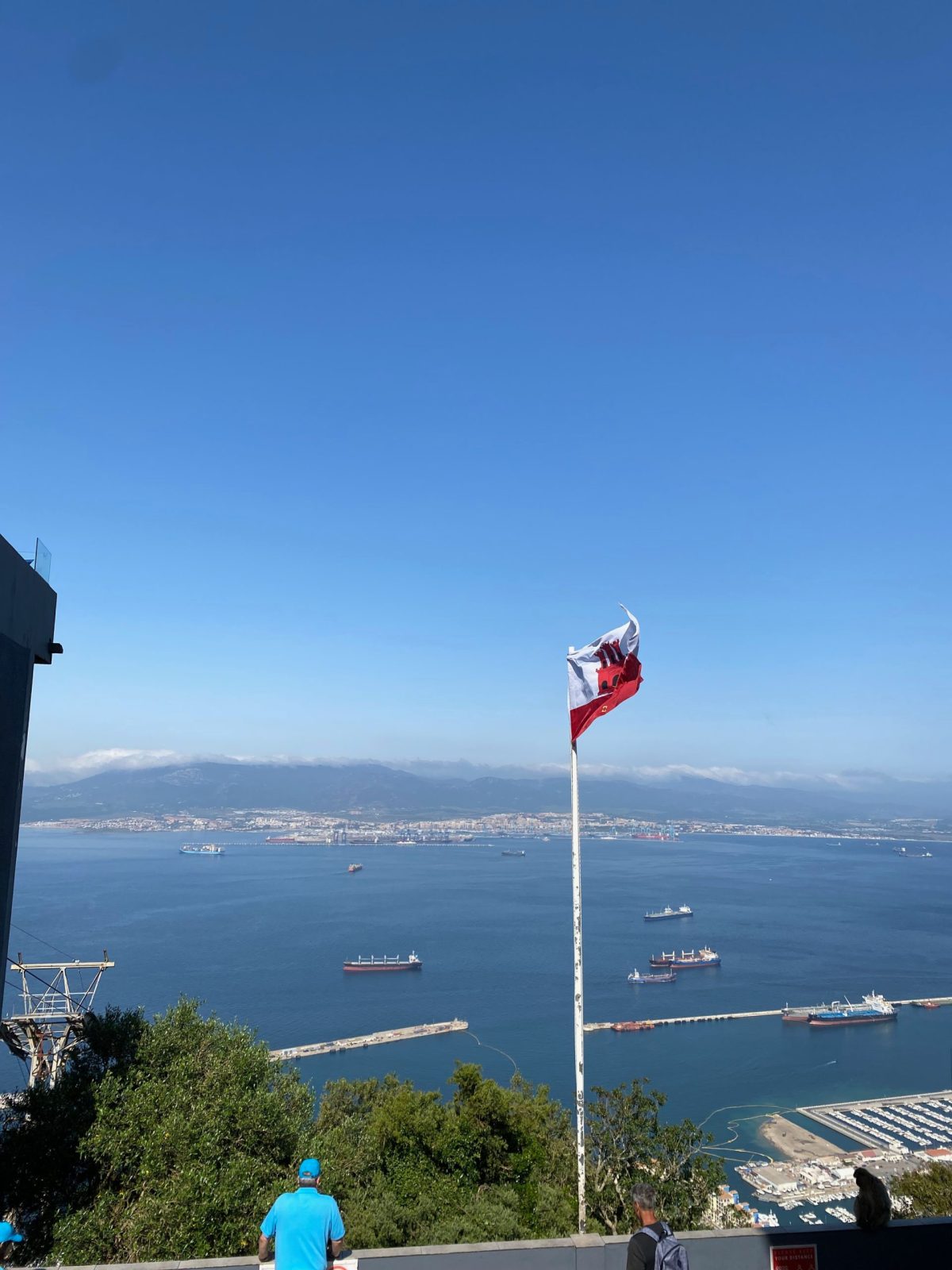

We continued down the path, choosing to bypass the Apes’ Den after our earlier monkey encounter. We did stop at the Great Siege Tunnels and at a Moorish castle that was built in the fourteenth century. Hot, dusty and tired, we stopped for a doner kebab from a takeaway shop before doing a bit of shopping and dropping some postcards in the mail. After that, it was back to the ship for dinner and the evening show. We even dropped by – and WON – a trivia contest!
Miles walked: 10 (including the equivalent of 42 flights of stairs!!)
Shore “excursion” cost per person: $60, including cable car & nature reserve admission, plus a quick lunch
May 24: Day at Sea
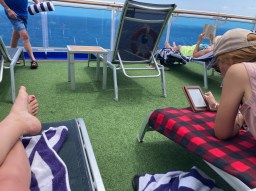
After a very busy day in Gibraltar, we were looking forward to another day at sea as our ship headed back up the Spanish coast and along the southern edge of France en route to the French Riveria. We ate breakfast in the buffet and did a little bit of work overlooking the sea. At about the halfway point in our trip, we sent our laundry out to be cleaned followed by lunch in the main dining room. Most of the afternoon was spent relaxing and reading in the sunshine, watching the waves roll by. For dinner, we chose to eat in Alfredo’s – the pizza restaurant that is one of the included complimentary restaurants on the ship. The food there was so good, and I have no idea why it was so empty! Sunshine made us sleepy, so we were out pretty early and ready for our adventure the next day.
Miles walked: 5.2
May 25: Marseille & Provence
Provence was one of the parts of the Mediterranean that I was most excited to see, and Marseille as a city didn’t really speak to me. Therefore, we decided to rent a car and go joyriding out in the countryside. The only bummer about the port in Marseille is that it is located pretty far outside the city center; it was easy to grab a taxi right after we got off the ship, but it was about a 35-40 minute ride into town to the car rental agency.
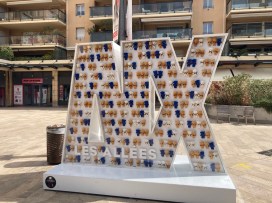
Enterprise Rental Car let us rent a tiny black manual transmission Fiat for the day, and we motored off into the countryside bound for Aix-en-Provence. Aix (pronounced EX) doesn’t have any major sights or famous history, but it is known for being just a delightful small town in Provence. The city is small but walkable and was exceptionally clean and tidy. Walking through town, it was easy for me to see why so many impressionist artists ended up falling in love with the light in Provence. We enjoyed a self-guided walking tour, found some macarons, and ate croissants in a cafe.
My original intent for the day in Provence was to head as far west as Avignon, but the day seemed to be slipping away from us and the employee at the car rental place had recommended the seaside village of Cassis as a place to go. So off we went to Cassis.
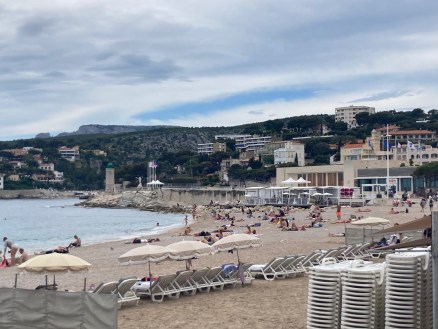
Cassis is the jumping-off point to visit the calanques, the Mediterranean inlets surrounded by high cliffs. It is very popular with the French but flies a bit under the radar with visitors from outside the region. It is quintessentially French; outdoor cafes populate the waterfront, a pebbly beach was filled with sunseekers, and the boules (bocce ball) pitch took pride of place in the center of town. We had joked a bit before the trip that our goals for the cruise were to enjoy the culture and the food and not feel pressured to check sights off a list. The day in Provence was a good example of this! It may not make for great storytelling, but I can’t wait to go back and spend some time in the area.
We headed back to Marseilles to return the car and begin the journey back to the ship. We ended up taking a taxi from a taxi stand back to the port, and walked on the ship about an hour before all-aboard. We opted for pizza from Alfredo’s again for dinner; while we were eating, the captain announced over the ship’s loudspeaker that we would be leaving late because someone had missed the ship! The crazy thing to me is that the captain announced by name the couple who were not yet on board; our waitstaff seemed very invested in figuring out if the couple made it back. The captain never did announce if they made it, and we pulled out of the dock about half an hour later. The late departure time did allow us to go up on deck and watch the sail-away.
Finally, we caught the evening production show, a tribute to soul music. I was very impressed by the live entertainment on the ship, and this show was no exception. The four main singers showed a wide range of talent, and I am always a bit in awe of people who can do complicated dancing on a moving ship! Although seemingly small, I really appreciated that the backup music was played by a live band; I had expected a recorded track, and having live musicians really added to the quality. Even if you’re not into the shows, it’s worth popping in on a couple during a cruise just to check them out.
MIles walked: 8.1
Shore “excursion” cost, per person: $50, includes taxi to/from port, fuel for the car, and lunch (I had a free car rental day, so that cost was covered).
May 26: Genoa & the Italian Riveria
I had somewhat low expectations for this port stop, and it ended up being my favorite port of the whole trip! Genoa itself has been a major Mediterranean port for almost a thousand years, and the cruise port is located right in the middle of downtown. It was very convenient, and only about a fifteen-minute walk from the main train station.
Our stop in Genoa was long, with almost 14 hours in port. Many of the ship’s excursions traveled as far afield as Milan or the Italian lakes, and several others visited the Cinque Terre. The Cinque Terre, which I have never visited, is a series of five small car-free towns on the Italian coast connected together by a hiking trail and regional trains. Relatively quiet a few decades ago, the Cinque Terre now suffers from crowding and overtourism, especially when cruise ships descend on the region.
Although the Cinque Terre appeals to me, I felt pretty strongly that I didn’t want to visit along with the other 2000 people from our ship who were headed there. Additionally, it’s a region that begs for an extended visit over several days. For these reasons, we skipped the Cinque Terre; I’ll just have to plan another trip to Italy in the future.
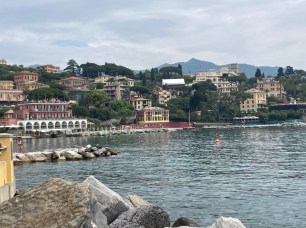
We opted instead to take the train from Genoa to a small town called Santa Margherita Ligure, with the intent of taking a boat from there to the resort town of Portofino. Santa Margherita Ligure is about a 40-minute inexpensive train ride from Genoa, and I fell in love with the town immediately. From the train station, a staircase tumbles down towards the natural harbor, and beaches, cafes, and a promenade ring the natural harbor of the town. Flowers were blooming, the sun was shining, and the town – while busy – was not crowded. We did see a small tour group from our ship early in the day, but the majority of the people we saw in town were Italian or French.
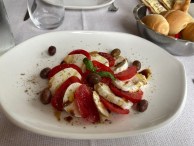
Lunch was at a delightful outdoor cafe on the waterfront, where we enjoyed tomato salad with mozzarella and pasta with pesto (the region’s specialty). We walked along the shore, checking out the shops, the architecture, and the beaches. We decided at this point just to stay in town for the afternoon rather than heading on to Portofino.
The beaches in this region are pebbly, although there are a few sandy beaches. The majority of the beaches are private affairs, where you pay a fee to enter but get a cushy chair, drink service, a place to change, restrooms, and sometimes even wifi for your entry fee. Since we were only in town for a few hours, we chose to spread out our beach towels on a public (free) beach but if I were spending a day solely on the beach, the private beaches would be worth the cost. For an hour or so, we soaked up the sun, enjoyed the scenery, and Mary even took a quick dip in the Mediterranean. It was absolutely perfect.
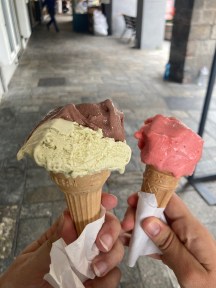
We found a gelato shop, did a little gift shopping at a local gift/food store, and wandered through the town a bit; we even stumbled into a movie/tv set doing active filming on one of the side streets. Afterward, we took the train back to Genoa and did a walk through the old part of the town before heading back to the ship.
I don’t think that I could have designed a more relaxing, sun-drenched, perfect day on the Italian Riveria if I had tried. I was pleasantly surprised by Genoa itself, and I could picture myself selling everything I own and moving to Santa Margherita Ligure.
Miles walked: 9.2
Shore “excursion” cost per person: $30, includes train to/from Santa Margherita Ligure and lunch
May 27: Livorno & Tuscany
On the list for the Livorno port stop was Pisa; I had been once before, but my friend Mary had never visited. Many cruise ship passengers use the Livorno port stop as a way to see Florence, but both of us had been there before and opted for a bit quieter of a day.
The port of Livorno is in the heart of Tuscany and is easily connected to Pisa, Lucca, Florence, and other Tuscan destinations. The one challenging part was getting from the ship to the train station to actually visit any of these spots! In contrast to any of the other ports we visited, Livorno did not allow you to simply walk from the ship to the port entrance. Your only way off the ship was to participate in a shore excursion, or take a paid shuttle bus to the port entrance and make your way from there. We opted for the paid shuttle and chose to walk to the train station from there. The train station was about a thirty-minute walk from the port, which was nice during the relatively cool hours of the morning.
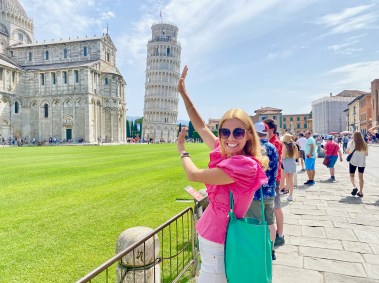
From the station, we took a short train ride to Pisa. In Pisa, we chose to visit the Field of Miracles; this is the home of the famous “leaning tower” as well as the cathedral and baptistry. All of these buildings are nearly a thousand years old but have been cleaned and maintained over the years in a way that has them absolutely gleaming. We weren’t interested in climbing the tower, but if that is something that you want to do when you visit you absolutely must book your tickets ahead of time. Pisa was crowded, with tons of large groups. And it was HOT. We took the obligatory photos and decided to head up the rail line to Lucca.
Lucca is about a twenty-minute train ride from Pisa and is another small town just made for strolling and enjoying the good life. It still has the majority of its medieval city wall intact, which now serves as a walking/biking path for residents and visitors alike. The walk from the train station into the heart of town, a piazza built from an ancient Roman amphitheater, took less than fifteen minutes. There, we enjoyed a slice of hearty ham & cheese focaccia and watched the people eating in the cafes and children playing soccer in the piazza.
We did some more shopping, stopping by a textile store where a woman working a loom was weaving the fabric for the scarves on display; I popped into one shop to buy some jarred truffles to bring home to my husband. We stuck our heads into the cathedral, and enjoyed some of the best gelato I’ve ever eaten at De’ Coltelli; I went for a combination of Sicilian pistachio and almond with lemon peel – highly recommend.
After that, it was time for the hour-long train ride back to Livorno, followed by a short bus ride back to the port entrance and the shuttle bus to the ship. We had enough time for a quick dip in the pool before heading to the main dining room for one last dinner and then packing up our bags to set outside our cabin to be taken off the ship for us.
Miles walked: 11.4
Total shore “excursion” cost per person: $25, including train/bus tickets, lunch and gelato
May 28: Disembarkation & Rome
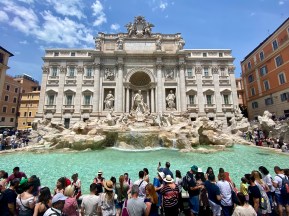
We were requested to leave our stateroom by 8:30 am, so we packed up and headed up to breakfast in the buffet around 8 am. Once finished, we were able to walk right off the ship. Our bags were waiting there for us, and we headed out of the cruise terminal. One nice thing about cruising in Europe is that most of the port stops are all within the European Union; this means that you do not have to go through customs or immigration as you disembark the ship! The port in Civitavecchia has a bus that runs right from the ship to the train station, and a quick train to Rome deposits you in the city center about an hour after you get off the ship.
We went from the train station to our hotel, Le Meridien Visconti near the Spanish Steps. Our room wasn’t quite ready yet, so we headed off to the Vatican to see St. Peter’s. Unfortunately, I was a bit unprepared for the level of crowding we saw in Rome; it felt a bit like every tourist in Europe was there on May 28! The line to get into St. Peter’s Basilica was wrapped completely around the square in the hot sunshine, so we decided to come back a bit later.
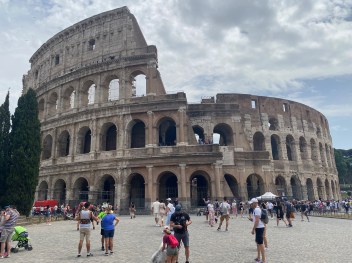
From the Vatican, we wandered through the old part of Rome, past the Pantheon (reservations required during weekends in summer) and down to the Roman Forum/Coliseum. Both of us had been to Rome in the past, so none of the sights were “must-do” for us, and we enjoyed just wandering and enjoying the atmosphere.
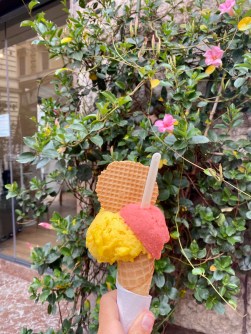
We headed back to the hotel via the subway to take care of our required USA-entry covid tests and shower before heading out for dinner. Unfortunately, we had a bit of an issue with one of the tests that we brought with us from home and had to ask the hotel concierge for help in finding a pharmacy to administer a test at the last minute. Our concierge was fantastic, and a quick trip to the pharmacy down the street resulted in a negative test certifying us fit to fly the next day.
Due to the unscheduled pharmacy stop, we never did make it back to St Peter’s and ended up doing an evening walk through the Piazza del Popolo and the Spanish Steps area before stopping for dinner at a small pizzeria near our hotel and one last pistachio gelato!
Miles walked: 13.5
Disembarkation costs, per person: $10, including bus to train station plus train into Rome
Flying Home
Every time I travel, I hope for uneventful flights. Our trip home started off rather uneventful, but a mechanical issue with our flight from Rome to Madrid resulted in an emergency-type landing and our plane having to be towed to the gate. Although we had a 2.5-hour layover in Madrid, we ended up having to sprint through the airport in order to make our flight back to the United States – which we did, barely! The nine-hour flight to Miami proceeded apace. However, the airport in Miami was an absolute zoo despite it being past 10:00 pm on a Sunday evening! We made it through, caught our connecting flight to Gainesville, and were reunited with our husbands shortly after midnight!
Post-Cruise Summary
Overall, I really liked this itinerary and would book it again. Gibraltar, while very neat, was sort of a “once-and-done” stop for me; if I were to cruise the Mediterranean again I would prefer another stop in France or Spain versus repeating Gibraltar. Genoa and the Italian Riveria knocked my socks off, and Lucca was such a great place to spend an afternoon.
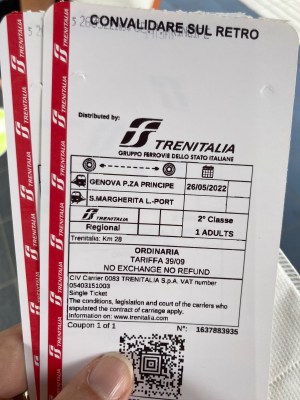
Most of our port stops were relatively long and provided plenty of time for us to feel like we didn’t have to rush while we were off the ship. With a little bit of planning and confidence, any traveler should be able to create their own excursions on a Mediterranean cruise. I highly recommend watching the port/destination talks on the ship (whether live or recorded) to give you an idea about where the ship will dock and the most efficient way to get into town.
The weather we had on the trip was absolutely perfect: sunny, warm, and just a few sprinkles of rain one day. I brought a jacket and never needed it; it got downright hot in Italy and I was glad we were traveling in May instead of July. And because we ate in mostly the free venues and neither of us is a really big drinker, I only spent about $50 on the ship (other than the actual cruise fare and the money I paid for the massage).
I am typically a “go-go-go” traveler when I go to Europe, and I wasn’t sure how I would enjoy the “forced” downtime on a cruise or if I would feel like I didn’t have enough time to get a sense of a place. Both fears were assuaged fairly quickly. It’s easy to forget how much time you lose on a European trip when you’re switching cities: packing, checking out of your hotel, getting to the train station, traveling to the next town, getting to your next hotel, checking in, unpacking, getting oriented. All of that takes up a massive amount of time and can be somewhat stressful.

On a cruise, you don’t have to worry about any of that! You also don’t have the emotional weight of trying to figure out where to eat every night; you basically show up, and food appears in front of you. The days at sea and the down time in the evenings allowed me to actually relax on vacation and I came back feeling refreshed instead of tired. I enjoy the other style of travel a lot, so I don’t picture every trip I take from now on to be a cruise. However, it’s a really nice addition to my toolbox of travel skills!
Total miles walked: 84.6 (over 90 if you include departure day in the airports!)
Total spent on shore “excursions,” per person: $220
Total spent on the ship, per person: $125 (includes internet plus extras)
Total hotel costs in Barcelona & Rome, per person: $137.50
Total “extras” cost, per person: $250 (includes massage on the ship which was the bulk of this cost, souvenirs, and other miscellaneous items)
Total spent in Europe, not including actual cruise fare and airfare: Approximately $732, per person
Why A European Cruise Should be Your Next Family Vacation
If you’ve been wanting to take your kids to Europe, or maybe want to plan a multigenerational family trip overseas, a cruise is an excellent way to do both things. Whether you are an experienced overseas traveler or it’s your first time out of the country, a cruise is a great way to dip your toe into international travel. Here are a few reasons why you should consider a European cruise for your next family vacation.
See Many Places, Unpack Once
A cruise can be a reconnaissance mission. Because you get to visit several cities or countries over the course of a week or so, a cruise can be a great way to introduce your kids to new cultures, experiences, or locations. This type of vacation gives you an opportunity to scout out places to which you’d like to return and stay a little longer, or discover unfamiliar things with the ability to return to a comfortable bed and familiar foods at the end of the day. You don’t have to worry too much about packing light, and you really get to settle into your home base cabin for the duration of your cruise.
Variety of Entertainment for all tastes
Cruises in all parts of the world are well known for providing a variety of entertainment options that appeal to all sorts of people. If you want to lounge by the pool on your sea days and have the convenience of a big bus tour of your ports, you can do that. If you prefer to be active every day and hit the gym, or participate in every planned event on the ship, those options exist! You can be as active or social as you prefer. Kids have special activities planned for them in the various kid’s clubs, which can also allow parents some adults-only time on vacation!
Minimal Logistical Hassle while retaining some independence (if you want it)
Because many cruise lines are based in the United States, the main language spoken on the ship is English. You won’t need any plug adapters, and you can usually pay for items in your preferred currency. None of these things are major hassles if you’re taking a land-based trip, but especially if you are new to international travel it can be nice to not have to think about them. You do NOT have to participate in the ship excursions in most instances; if you prefer to be completely independent onshore, that is up to you. You can even choose to stay on the ship while it is in port if sleeping in or a day by the pool sounds more appealing than an excursion.
Lots of Included Value
Cruises can be a really good value. For one price, you get your lodging, several meals, and entertainment included in your upfront vacation price. If you book far enough ahead of time, you can make payments over time. This allows you to have the majority of your vacation paid for in advance and can be very helpful from a budgeting standpoint. Plus, most travel agents have additional benefits, perks or shipboard credit to share with clients when you book with an agent!
Enough time to actually relax!
Princess’s motto is “Come Back New.” I really felt refreshed, not exhausted as I have been on some trips to Europe. A week-long cruise, plus a night in a hotel on either end of the trip felt like the right amount of time. This type of itinerary is relatively easy to fit in a one-week-leave-from-work scenario, but still gives you some downtime and quiet moments.
Overall, I would encourage anyone to consider a cruise in Europe for your next trip!
Ready to plan your European adventure? Get started here.
Related
What I Did Over the Summer, 2022 VersionSimilar post
How I Make Money as a Travel AgentSimilar post
Reflecting on 2021In "2021"

